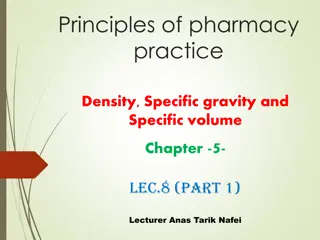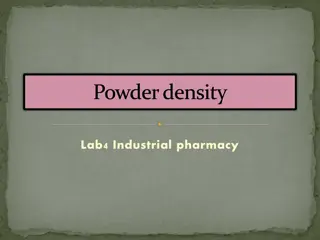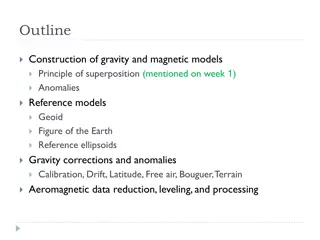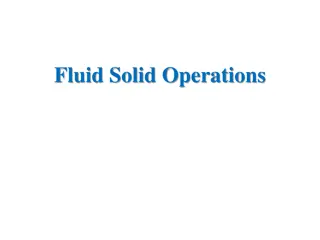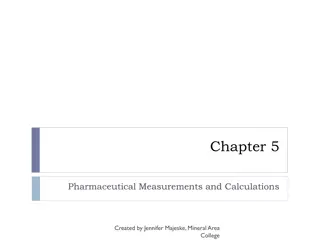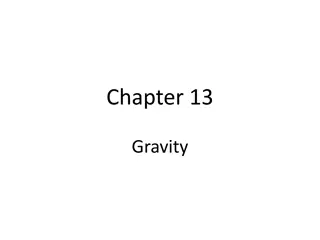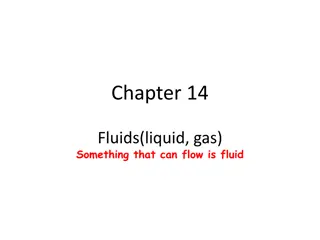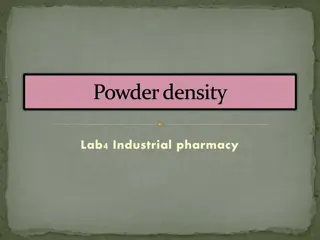Principles of Pharmacy Practice: Density and Specific Gravity
The concepts of density and specific gravity is essential in pharmacy practice. Density is the mass per unit volume of a substance, while specific gravity is the ratio of the weight of a substance to the weight of an equal volume of a standard substance. Learn how to calculate and apply these principles in pharmaceutical formulations.
Download Presentation

Please find below an Image/Link to download the presentation.
The content on the website is provided AS IS for your information and personal use only. It may not be sold, licensed, or shared on other websites without obtaining consent from the author.If you encounter any issues during the download, it is possible that the publisher has removed the file from their server.
You are allowed to download the files provided on this website for personal or commercial use, subject to the condition that they are used lawfully. All files are the property of their respective owners.
The content on the website is provided AS IS for your information and personal use only. It may not be sold, licensed, or shared on other websites without obtaining consent from the author.
E N D
Presentation Transcript
Principles of pharmacy practice Lec 1 Lecturer Dr Athmar Dhahir Habeeb Al-Shohani PhD in industrial pharmacy and pharmaceutical formulations athmar1978@uomustansiriyah.edu.iq athmar1978@yahoo.com athmar.habeeb.12@ucl.ac.uk
Density, Specific Gravity, and Specific Volume Density (d) is mass per unit volume of a substance. It is usually expressed as grams per cubic centimeter (g/cc). Because the gram is defined as the mass of 1 cc of water at 4oC, the density of water is 1 g/cc. For our purposes, because the United States Pharmacopeia1 states that 1 mL may be used as the equivalent of 1 cc, the density of water may be expressed as 1 g/mL Density may be calculated by dividing mass by volume, that is:
Thus, if 10 mL of sulfuric acid weighs 18 g, its density is:
Specific gravity Specific gravity (sp gr) is a ratio, expressed decimally, of the weight of a substance to the weight of an equal volume of a substance chosen as a standard, both substances at the same temperature or the temperature of each being known. Water is used as the standard for the specific gravities of liquids and solids; the most useful standard for gases is hydrogen. Specific gravity may be calculated by dividing the weight of a given substance by the weight of an equal volume of water, that is:
Thus, if 10 mL of sulfuric acid weighs 18 g, and 10 mL of water, under similar conditions, weighs 10 g, the specific gravity of the acid is: Substances that have a specific gravity less than 1 are lighter than water. Substances that have a specific gravity greater than 1 are heavier than water
* If 54.96 mL of oil weighs 52.78 g, what is the specific gravity of the oil? 54.96 mL of water weighs 54.96 g Specific gravity of oil= 52.78 (g)/ 54.96 (g) = 0.9603, answer. * If a pint of a certain liquid weighs 601 g, what is the specific gravity of the liquid? 1 pint =473 mL. 473 mL of water weighs 473 g Specific gravity of liquid= 601 (g) /473 (g) = 1.27, answer.
Pycnometer or Specific Gravity Bottle A pycnometer is a special glass bottle used to determine specific gravity. Pycnometers are generally available for laboratory use in volumes ranging from 1 mL to 50 mL. Pycnometers have fitted glass stoppers with a capillary trapped air and excess fluid to escape. Some pycnometers thermometers temperature is a factor in specific gravity determinations. opening to allow have affixed, because
Example: A 50 mL pycnometer is found to weigh 120 g when empty, 171 g when filled with water, and 160 g when filled with an unknown liquid. Calculate the specific gravity of the unknown liquid. Weight of water: 171 g - 120 g = 51 g Weight of unknown liquid: 160 g - 120 g = 40 g Specific gravity= Weight of substance/ Weight of equal volume of water Specific gravity of unknown liquid = 40 (g)/ 51 (g) = 0.78, answer.
Calculating Weight, Knowing the Volume and Specific Gravity Grams = Milliliters Specific gravity Grams (other liquid)= Grams (of equal volume of water) Specific gravity (other liquid) Example: What is the weight, in grams, of 2 fl. oz. of a liquid having a specific gravity of 1.118? 2 29.57 mL =59.14 mL 59.14 mL of water weigh 59.14 g 59.14 g 1.118 =66.12 g, answer. What is the cost of 1000 mL of glycerin, specific gravity 1.25, bought at $54.25 per pound? 1000 mL of water weigh 1000 g Weight of 1000 mL of glycerin =1000 g 1.25 =1250 g 1 lb =454 g 454 (g) /1250 (g) = ($) 54.25 ($) /x x = $149.37, answer
Calculating Specific Volume Specific volume, in pharmaceutical practice, is usually defined as an abstract number representing the ratio, expressed decimally, of the volume of a substance to the volume of an equal weight of another substance taken as a standard, temperature. Water is the standard. Example: both having the same Calculate the specific volume of a syrup, 91.0 mL of which weighs 107.16 g. 107.16 g of water measures= 107.16 mL Specific volume of syrup = 91.0 (mL) /107.16 (mL) = 0.849, answer
Because reciprocals, a substance that is heavier than water will have a higher specific gravity and a lower specific volume, whereas a substance that is lighter than water will have a lower specific gravity and a higher specific volume. It follows, therefore, that we may determine the specific volume of a substance by dividing 1 by its specific gravity, and we may determine the specific gravity of a substance by dividing 1 by its specific volume. specific gravity and specific volume are






